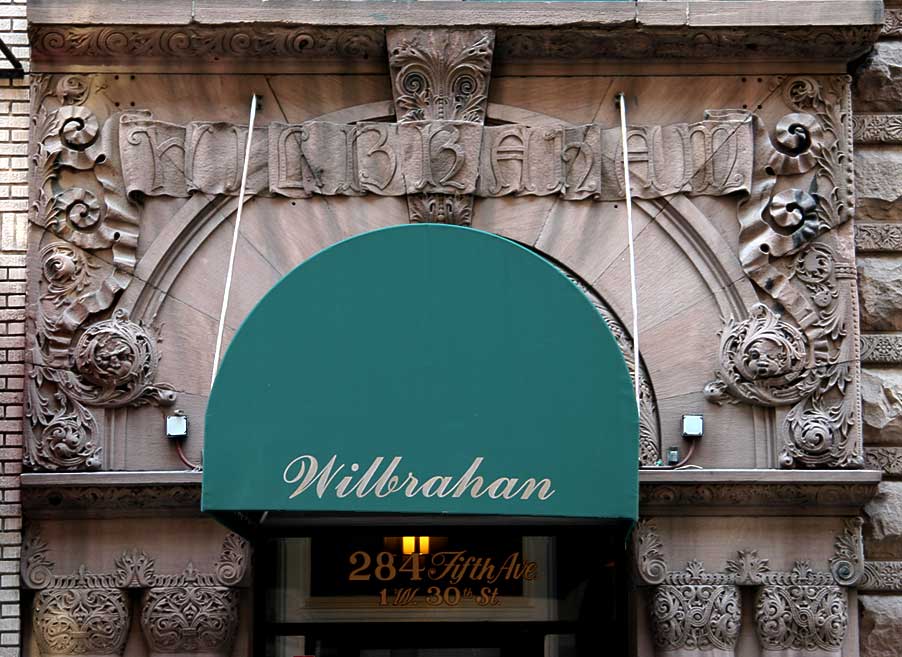
Wilbraham Apartments., 1 W. 30th St. (2007)

In 1908 the New York Times wrote, "Frederick Fox & Co. have sold the eight-story Wilbraham building at 284 Fifth Avenue, northwest corner of Thirtieth Street, opposite the Holland House. The structure, which covers a plot 40 by 125, was one of the first and finest bachelor apartment houses erected in the Fifth Avenue section, and was owned by Mrs. Emily H. Moir. The present buyer is John J. Gibbons, head of the firm of Gilman, Collamore & Co., who have occupied the store, basement and first loft ever since the building was erected. The consideration in the deal was $1,000,000. In commenting on the purchase yesterday Mr. Gibbons expressed the belief that this part of Fifth Avenue, by reason of its accessibility, will continue to be the best for high-class retail trade. Mrs. Moir bought the site of the Wilbraham, then occupied by old dwellings, in 1888, through Broker Herbert A. Sherman, for $245,000. The upper part of the building will continue to be used for bachelor apartments."
The original owner, William Moir (1826-1896), received the following obituary notice in the New York Times, 22 March 1896, "William Moir died suddenly at 10 o'clock last night at his home, 6 West Twentieth Street. He had been in ill health for some time. He was Sixty-nine years old, and was born in Aberdeen, Scotland. He came to this city in 1835, and started business as a jeweler in Hudson Street. Later, he moved to Sixth Avenue and Twenty-third Street. He was a member of the St. Andrew's Society, a Trustee of the Greenwich Savings Bank, and up to a short time ago had been Treasurer of the First Presbyterian Church."
The AIA Guide to New York, 4th edition, 2000, by Norval White & Elliott Willensky, has the following, "Wilbraham Building (originally apartments), 284 Fifth Ave., NW cor. W. 30th St. 1890. David & John Jardine. Brownstone and brick Belle Epoque crowned by a verdigris copper roof - one of the earliest settlers on Fifth Avenue. Here the Brown Decades that preceded the Great White City of the 1893 Chicago World's Fair were still exuding their somewhat murky medievalism, but propped up by Classical composite cast-iron columns and limestone piers."
An extensive report by the New York City Landmarks Preservation Commission (8 June 2004) is available on the internet. The report includes the summary, "The Wilbraham, built in 1888-90 as a bachelor apartment hotel, was commissioned by prominent Scottish-American jeweler William Moir as a real estate investment. It was designed by the versatile New York architectural firm of D. & J. Jardine, whose principals, David and John Jardine, were brothers and also of Scottish birth. Located at the northwest corner of Fifth Avenue and West 30th Street, the Wilbraham is eight stories high (plus basement and penthouse) and crowned by a mansard roof. Clad in a handsome combination of Philadelphia brick, Belleville brownstone, and cast iron, the Wilbraham is extraordinarily well-detailed and reflects the influence of the Romanesque Revival style in the rock-faced stonework and excellent, intricately carved stone detail. The Real Estate Record & Guide in 1890 called it 'quite an imposing piece of architecture.' The building’s twostory shopfront housed the famous china and glassware importing firm of Gilman Collamore & Co. from 1890 to about 1920. The Wilbraham was constructed when this area was changing due to the inroads of commerce, but was still fashionable for clubs, theaters, apartments, and hotels. The bachelor apartment hotel, or 'bachelor flats,' was a multiple dwelling building type that arose in the 1870s to serve the city’s very large population of single men. The Wilbraham catered to professional men of means. Each apartment contained a two-room suite with a bathroom but no kitchen; a residents’ dining room was provided on the eighth floor. In 1934-35, the apartments were remodeled to include kitchens, and the building ceased to operate solely as bachelor flats. The Wilbraham, an outstanding extant example of the bachelor apartment hotel building type, has remained in residential use."
The Wilbraham is a designated New York City landmark and is described as such in Guide to New York City Landmarks, edited by Matthew A. Postal, 4th edition, 2009, p. 80-81, "The Wilbraham, 1 West 30th Street (D. & J. Jardine, 1888-90), designated 2004. Constructed as an apartment hotel, the Wilbraham is a brick and brownstone Romanesque Revival structure, crowned by a mansard roof. This type of short-term housing, also known as 'bachelor flats,' appealed to professional men in the late 19th century. Suites included bathrooms but no kitchen, and a dining room was provided on the top floor. During the mid-1930s, the apartments were remodeled and kitchens were added. Gilman Collamore & Co., dealers in fine china and imported goods, leased the two-story storefront from 1890 to 1920."
A Wikipedia article on the Wilbraham is found at wikipedia.org.
< previous || next > index map signs by date signs by name see what's new